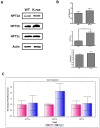Knockdown of the sodium-dependent phosphate co-transporter 2b (NPT2b) suppresses lung tumorigenesis
- PMID: 24194864
- PMCID: PMC3806752
- DOI: 10.1371/journal.pone.0077121
Knockdown of the sodium-dependent phosphate co-transporter 2b (NPT2b) suppresses lung tumorigenesis
Erratum in
-
Correction: Knockdown of the Sodium-Dependent Phosphate Co-Transporter 2b (NPT2b) Suppresses Lung Tumorigenesis.PLoS One. 2014 Jan 9;9(1):10.1371/annotation/08286cd8-527f-4f14-856f-57267107efa8. doi: 10.1371/annotation/08286cd8-527f-4f14-856f-57267107efa8. eCollection 2014. PLoS One. 2014. PMID: 29161733 Free PMC article.
Abstract
The sodium-dependent phosphate co-transporter 2b (NPT2b) plays an important role in maintaining phosphate homeostasis. In previous studies, we have shown that high dietary inorganic phosphate (Pi) consumption in mice stimulated lung tumorigenesis and increased NPT2b expression. NPT2b has also been found to be highly expressed in human lung cancer tissues. The association of high expression of NPT2b in the lung with poor prognosis in oncogenic lung diseases prompted us to test whether knockdown of NPT2b may regulate lung cancer growth. To address this issue, aerosols that contained small interfering RNA (siRNA) directed against NPT2b (siNPT2b) were delivered into the lungs of K-ras (LA1) mice, which constitute a murine model reflecting human lung cancer. Our results clearly showed that repeated aerosol delivery of siNPT2b successfully suppressed lung cancer growth and decreased cancer cell proliferation and angiogenesis, while facilitating apoptosis. These results strongly suggest that NPT2b plays a role lung tumorigenesis and represents a novel target for lung cancer therapy.
Conflict of interest statement
Figures




References
-
- Lee HY, Suh YA, Kosmeder JW, Pezzuto JM, Hong WK, et al. (2004) Deguelin-induced inhibition of cyclooxygenase-2 expression in human bronchial epithelial cells. Clin Cancer Res 10: 1074–1079. - PubMed
-
- Khuri FR, Herbst RS, Fossella FV (2001) Emerging therapies in non-small-cell lung cancer. Ann Oncol 12: 739–744. - PubMed
-
- Densmore CL (2003) The re-emergence of aerosol gene delivery: a viable approach to lung cancer therapy. Curr Cancer Drug Targets 3: 275–286. - PubMed
-
- Jemal A, Siegel R, Xu J, Ward E (2010) Cancer statistics, 2010. CA Cancer J Clin 60: 277–300. - PubMed
-
- Virkki LV, Biber J, Murer H, Forster IC (2007) Phosphate transporters: a tale of two solute carrier families. Am J Physiol Renal Physiol 293: 643–654. - PubMed
Publication types
MeSH terms
Substances
Grants and funding
LinkOut - more resources
Full Text Sources
Other Literature Sources
Medical
Molecular Biology Databases
Research Materials
Miscellaneous

